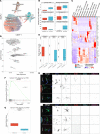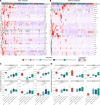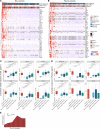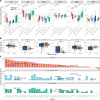Prolonged exposure to lung-derived cytokines is associated with activation of microglia in patients with COVID-19
- PMID: 38502186
- PMCID: PMC11141878
- DOI: 10.1172/jci.insight.178859
Prolonged exposure to lung-derived cytokines is associated with activation of microglia in patients with COVID-19
Abstract
BACKGROUNDSurvivors of pneumonia, including SARS-CoV-2 pneumonia, are at increased risk for cognitive dysfunction and dementia. In rodent models, cognitive dysfunction following pneumonia has been linked to the systemic release of lung-derived pro-inflammatory cytokines. Microglia are poised to respond to inflammatory signals from the circulation, and their dysfunction has been linked to cognitive impairment in murine models of dementia and in humans.METHODSWe measured levels of 55 cytokines and chemokines in bronchoalveolar lavage fluid and plasma from 341 patients with respiratory failure and 13 healthy controls, including 93 unvaccinated patients with COVID-19 and 203 patients with other causes of pneumonia. We used flow cytometry to sort neuroimmune cells from postmortem brain tissue from 5 patients who died from COVID-19 and 3 patients who died from other causes for single-cell RNA-sequencing.RESULTSMicroglia from patients with COVID-19 exhibited a transcriptomic signature suggestive of their activation by circulating pro-inflammatory cytokines. Peak levels of pro-inflammatory cytokines were similar in patients with pneumonia irrespective of etiology, but cumulative cytokine exposure was higher in patients with COVID-19. Treatment with corticosteroids reduced expression of COVID-19-specific cytokines.CONCLUSIONProlonged lung inflammation results in sustained elevations in circulating cytokines in patients with SARS-CoV-2 pneumonia compared with those with pneumonia secondary to other pathogens. Microglia from patients with COVID-19 exhibit transcriptional responses to inflammatory cytokines. These findings support data from rodent models causally linking systemic inflammation with cognitive dysfunction in pneumonia and support further investigation into the role of microglia in pneumonia-related cognitive dysfunction.FUNDINGSCRIPT U19AI135964, UL1TR001422, P01AG049665, P01HL154998, R01HL149883, R01LM013337, R01HL153122, R01HL147290, R01HL147575, R01HL158139, R01ES034350, R01ES027574, I01CX001777, U01TR003528, R21AG075423, T32AG020506, F31AG071225, T32HL076139.
Keywords: COVID-19; Cellular immune response; Cytokines; Immunology; NF-kappaB.
Figures




Update of
-
Prolonged exposure to lung-derived cytokines is associated with inflammatory activation of microglia in patients with COVID-19.bioRxiv [Preprint]. 2023 Jul 28:2023.07.28.550765. doi: 10.1101/2023.07.28.550765. bioRxiv. 2023. Update in: JCI Insight. 2024 Mar 19;9(8):e178859. doi: 10.1172/jci.insight.178859. PMID: 37546860 Free PMC article. Updated. Preprint.
References
Publication types
MeSH terms
Substances
Grants and funding
- R01 HL153122/HL/NHLBI NIH HHS/United States
- R21 AG075423/AG/NIA NIH HHS/United States
- S10 OD011996/OD/NIH HHS/United States
- U19 AI135964/AI/NIAID NIH HHS/United States
- P01 HL154998/HL/NHLBI NIH HHS/United States
- U01 TR003528/TR/NCATS NIH HHS/United States
- R01 LM013337/LM/NLM NIH HHS/United States
- R01 HL147290/HL/NHLBI NIH HHS/United States
- R01 HL147575/HL/NHLBI NIH HHS/United States
- T32 HL076139/HL/NHLBI NIH HHS/United States
- I01 CX001777/CX/CSRD VA/United States
- R01 ES034350/ES/NIEHS NIH HHS/United States
- R01 ES027574/ES/NIEHS NIH HHS/United States
- P01 AG049665/AG/NIA NIH HHS/United States
- R01 HL153312/HL/NHLBI NIH HHS/United States
- UL1 TR001422/TR/NCATS NIH HHS/United States
- T32 AG020506/AG/NIA NIH HHS/United States
- R01 HL158139/HL/NHLBI NIH HHS/United States
- P30 CA060553/CA/NCI NIH HHS/United States
- F31 AG071225/AG/NIA NIH HHS/United States
- R01 HL149883/HL/NHLBI NIH HHS/United States
LinkOut - more resources
Full Text Sources
Medical
Molecular Biology Databases
Miscellaneous

